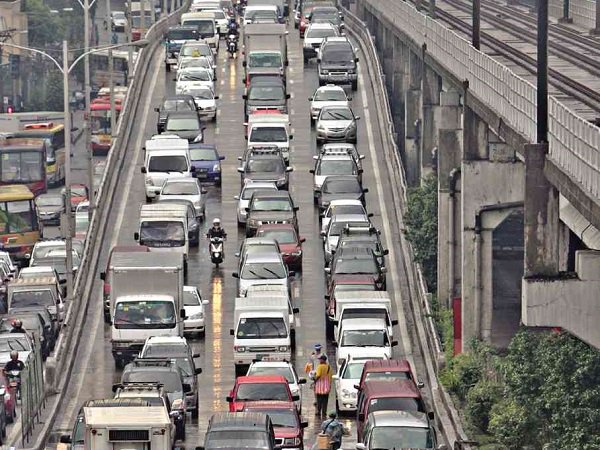PLDT, Globe to provide free high-speed WiFI to people on Edsa

Epifano de los Santos Avenue (INQUIRER FILE PHOTO)
MANILA — Forget the creeping traffic on EDSA—at least the internet is fast.
This is the latest promise of the Department of Information and Communications Technology (DICT), which enlisted the help of telecommunication giants PLDT Inc. and Globe Telecom for the June 12,
2017 launch of its high-speed Wi-Fi project on EDSA.
DICT Secretary Salalima said on Monday, the move was in line with President Duterte’s directive to provide free internet access in public places nationwide.
Mr. Duterte has been especially critical of the country’s two telco players, having called them out in the past on their service quality and high costs, presumably referring to fixed-line broadband.
The President threatened to bring in new foreign competitors, without detailing the steps he would take to achieve this.
PLDT and Globe, whose foreign shareholders include Japan’s NTT Group and Singapore Telecommunications, respectively, said they would provide high-speed WiFi for commuters and motorists using the entire 24-kilometer stretch of EDSA.
The thoroughfare, which cuts through Caloocan, Quezon City, San Juan, Mandaluyong, Makati and Pasay, is one of the country’s busiest and most congested roads, where multi-hour traffic jams are accepted as the norm.
“We work to give Filipinos access to the information and technology that they need in their daily lives. EDSA Wi-Fi will benefit the hundreds of thousands of commuters along EDSA daily,” Salalima said.
PLDT’s Smart Communications and Globe said they would each provide 30 minutes of free high-speed WiFi to motorists and commuters per day. Users would be asked to pay for additional data usage in excess of the 30 minutes, both telcos said.
PLDT and Globe stopped short of guaranteeing figures on internet speed, which has been partly dependent on the network infrastructure and the number of users availing of the service.
PLDT said in a statement that its “carrier-grade WiFi along EDSA” would benefit half a million riders of the Metro Rail Transit Line 3 that ran along the thoroughfare apart from passengers in over 326,000
vehicles that use EDSA daily.
Globe did the same via its GoWiFi platform, adding that download speeds can reach “up to” 100 megabits per second.
“This is in line with our firm commitment to build cutting-edge digital infrastructure that will help power the country’s development and enrich the lives of our people,” Manuel V. Pangilinan, PLDT chair
and CEO, said in a statement.
“Globe is committed to improving the state of internet in the Philippines by continuously rolling out the needed infrastructure to ensure that our customers are always connected,” Globe CEO Ernest Cu
said.
“Today, we are supporting the efforts of the government who is tapping our Go WiFi facilities for the EDSA WiFi project to achieve the same goal of one digital nation,” he added.
Both telcos have previously rolled out WiFi services across transport hubs, such as airports and train stations, and retail outlets.
The launch also comes as a pair of third-party studies this month showed the Philippines, while improving year-on-year, still far off from closing the gap with regional neighbors in terms of speed and
coverage.
United States-based Akamai Technologies said in a report last week that the Philippines’s first quarter 2017 average mobile internet speed hit 8.7 mbps, a 40 percent decline over the last quarter (year-on-year figures were not available).
On fixed-line broadband, the Philippines remained a laggard compared to the rest of the region with an average speed of 5.5 mbps. Telcos downplayed the figure, saying this was a 57 percent improvement over the same period last year.
Separately, a crowd-sourced survey from Untied Kingdom-based OpenSignal showed the latest figures on high-speed mobile internet, or LTE. In its June 2017 report, the Philippines stayed near the bottom
globally, albeit with improvements over last year.
It said LTE speed in the Philippines stood at 8.59 mbps, better than 7.27 mbps six months ago, while LTE availability stood at 53 percent, up from 44.8 percent. OpenSignal said the global average LTE speed was 16.2 mbps.
In its statement, the DICT said PLDT and Globe would handle different “schemes and access points for this free public Wi-Fi offering”
“We welcome the cooperation of the private sector on this endeavor as we aim to give people choices,” Salalima said.
Aside from the EDSA Wi-Fi Project, the DICT said it has started rolling out the “Free Wi-Fi Internet Access in Public Places project” across the country. The department is targeting to reach over 13,000
public places across 145 cities and 1,489 municipalities. SFM